Strong quads are vital for full-body fitness, and adding dumbbells to your leg exercises will bring you a whole new world of quad strength.
You can simply and effectively train your quads at home with just a pair of dumbbells and a small space.
In fact, dumbbells tend to get the job done better than fancy machines and barbell racks. It allows you to do it at home without buying expensive gym equipment.
Here are my 10 best quadriceps dumbbell exercises with a workout routine to help build mass and strength.
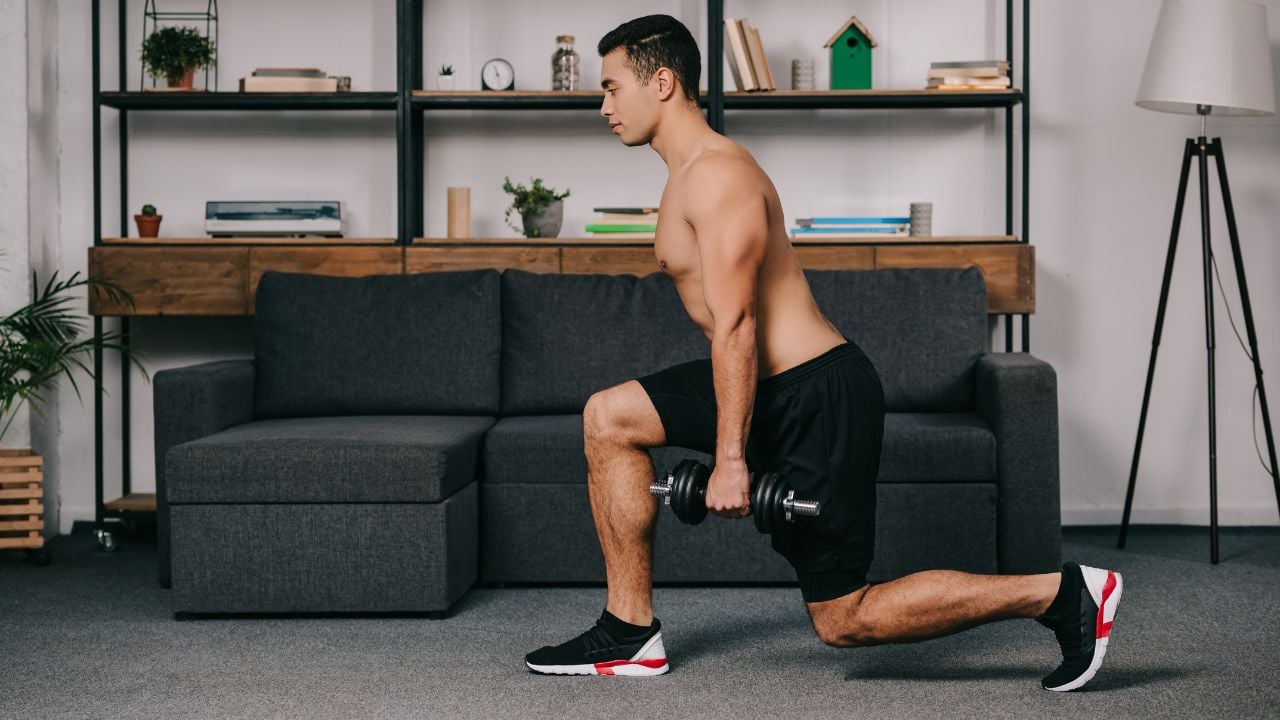
- 10 Quadriceps Workouts With Dumbbells
- 1. Dumbbell Squat
- 2. Dumbbell Bulgarian Split Squat
- 3. Dumbbell Lunges
- 4. Dumbbell Sumo Squat
- 5. Dumbbell Jump Squat
- 6. Dumbbell Front Squat
- 7. Dumbbell Reverse Lunges
- 8. Dumbbell Box Squat
- 9. Dumbbell Step Up
- 10. Dumbbell Goblet Squat
- How To Build Quadriceps Mass (With Workout Plan)
- 1. Set And Reps To Mass, Power, And Endurance
- 2. Select Weekly Workout Volume
- 3. Quad Workout for Beginners
- 4. Intermediate Quadriceps Workout Routine
- 5. Advance Workout Routine
- Benefits of Doing Quad Exercises With Dumbbell
- FAQs
- Are dumbbell quad exercises suitable for beginners?
- How many quad exercises per workout
- Can I do dumbbell quad exercises at home?
- Takeaways
10 Quadriceps Workouts With Dumbbells
These dumbbell quad exercises can be done by people of different levels and for different purposes, such as building power, strength, muscle mass, and endurance.
1. Dumbbell Squat
If you’re looking for straightforward quad-dumbbell exercises to add to your routine, dumbbell squats are a great staple exercise to start with.
It is a classic lower-body exercise where you hold a dumbbell in each hand at your sides while performing a squat.
It is an excellent alternative to barbell squats as they help build muscle mass in the quad muscles.

How To Do
- Hold a dumbbell in each hand at your sides, with your palms facing inward.
- Stand with your feet shoulder-width apart and keep your toes slightly pointed outwards.
- Bend your hips and then knees, sending your hips back as if sitting into a chair.
- Now raise yourself up using only the thigh power until your legs are nearly locked out.
- Do 8–10 reps and 3–4 sets.
Tips
- Keep your torso upright, shoulders back, head up, and feet flat.
- Aim to lower yourself until your thighs are at least parallel to the floor.
- Keep knees aligned with your toes, don’t let them collapse inwards or outwards
2. Dumbbell Bulgarian Split Squat
The Dumbbell Bulgarian Split Squat is another great exercise to improve balance and build unilateral functional strength.
Because your rear foot is elevated and not in contact with the floor, you have effectively isolated it from the exercise. This means you rely heavily on the forward leg’s quadriceps to lift a significant portion of your weight.
- If you want to emphasize the quads during the split squat, you should take a slightly smaller split stance and drive up through the ball of your foot.
- If you want to focus on the glutes and hamstrings during the split squat, focus on taking a bigger split stance and driving up through the heel of the foot.

How To Do
- Hold a dumbbell in each hand and stand with your back facing the side of a bench.
- There should be three or four feet between you and the bench.
- Extend one leg backward and place the top of your foot on the bench so that only one leg supports your body.
- Inhale as you squat down with your supporting leg until your back leg’s knee nearly touches the floor.
- Exhale as you push yourself back up to the starting position.
- Do 8–10 reps. Repeat the exercise with your opposite leg.
Tips
- When you squat, your front knee should not pass your toes.
- Keep your torso upright and your head facing forward.
- If you suffer from balance problems, avoiding them or using your body weight while holding on to a steady object is best.
3. Dumbbell Lunges
The dumbbell lunge is like taking a big step forward. Even though this exercise can be done without weights, using dumbbells works the quad muscles and glutes more.
- The forward lunges stimulate the quads more because they rely on the quads to lower themselves on the eccentric portion.
- The reverse lunge uses the hamstrings to control the eccentric.
It requires good balance, so if you have issues keeping your balance, start off by doing the lunges exercise without a dumbbell as you learn the proper form.
A study has shown that weightlifting with a dumbbell held on the opposite side of the working leg can strengthen the hip abductors.
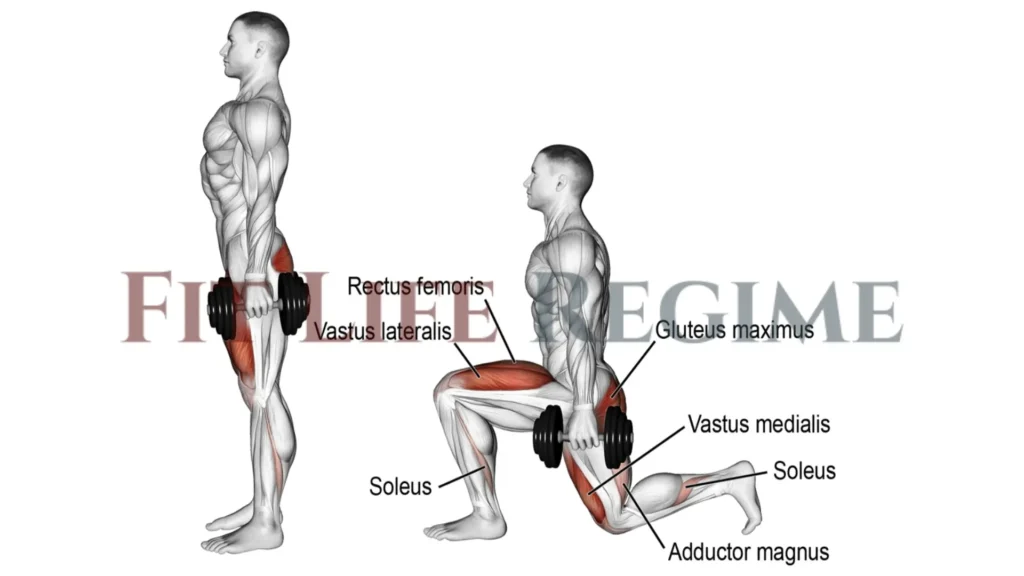
How To Do
- Grab a dumbbell in each hand, with your arms by your sides, and stand upright.
- Take a big step forward with your left leg, landing on the heels.
- Bend at the knee until the left thigh approaches parallel to the ground. The right leg is bent at the knee and balanced on the toes in a lunge position.
- Step your left foot back and exhale to return to the starting position.
- Repeat the motion with the right leg.
- Keep alternating the leg with which you lunge.
Tips
- Bend as far and low as possible without losing form.
- Keep your torso upright and your head facing forward.
- Dumbbell lunges can be done with dumbbells on the front of the shoulders.
- Adjust the width of your stance to find the right distance. If your feet are too close together, this puts more force on your knees than your thighs. If they are too far apart, you won’t be able to bend the rear leg as much, and your lunge will be less stable.
4. Dumbbell Sumo Squat
The sumo squat works your lower body muscles differently than a normal squat.
The wider stance than shoulder width increases the demand on the quads, glutes, hamstrings, and adductors while benefiting the quads, core, and upper body. Some research shows that stance width affects muscle activity in the lower extremities.
It is one of the best exercises to train your quad muscles with only a single dumbbell.
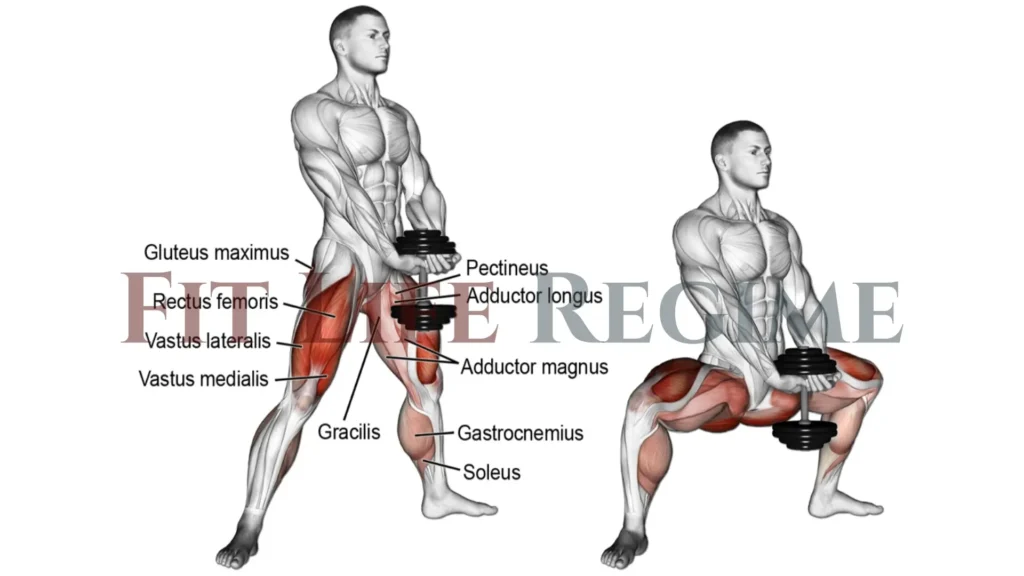
How To Do
- Stand with your feet much wider than shoulder-width apart, toes pointed outward at a comfortable angle.
- Hold dumbbells in each hand with your palms facing inward.
- By laterally rotating at the hip, angle your toes out and away from the center of your body (about 45 degrees).
- Flex your hips and bend your knees as you squat down.
- Ensure that your knees track over your toes and don’t collapse inward.
- Descend until your thighs are parallel to the floor or as far as your mobility allows.
- Hold the squatting position for a few seconds. Then, engage your glutes and push up to standing, driving up through your heels.
- Start with 3 sets of 8–12 reps.
Tips
- Do not allow the dumbbell to contact the floor.
- Make sure your knees are still tracking over your toes.
- Be mindful to keep your spine neutral, core engaged, and eyes forward throughout the movement.
- The lower back should have a natural arch with a chest out. Keep your abs tight throughout the exercise.
5. Dumbbell Jump Squat
Squat jumps are a great dumbbell leg exercise to include in-home quad workouts, since they can be done in a small space without any equipment.
Dumbbell Jump squats are the power-packed HIIT version of squats. This exercise is another great option for targeting the quads and growing your legs.
It helps people improve their power and explosive strength, especially for people who want to improve their vertical jump.

How To Do
- Stand with your feet about shoulder-width apart and your knees slightly bent.
- Quickly drop by bending at the knees and hips, letting your glutes track backward, and lowering yourself into a squat.
- When your thighs are parallel to the floor, quickly reverse direction and drive up through your heels and the balls of your feet to lift your body off the floor as high as possible.
- Land with soft knees and immediately lower into the next rep.
Tips
- Keep your head up and your torso upright.
- Don’t perform this exercise with cold muscles. Do a cardio warm-up before it.
6. Dumbbell Front Squat
The squat and the dumbbell front squat work the same target and synergistic muscles. However, the dumbbell front squat recruits more stabilizer muscles, including various back, shoulder, and arm muscles.
Front squats inherently place more focus on the quads compared to back squats.

How To Do
- Choose a pair of dumbbells you can comfortably hold in the front rack position.
- Stand with feet roughly hip-width to shoulder-width apart, toes pointing slightly outward.
- Lift the dumbbells up to your shoulders and rest them on the front shoulder.
- Your upper arms should be close to parallel with the floor, elbows high.
- Make sure the dumbbells feel secure in this position.
- Bend your knees and drive your hips back to lower yourself until your thighs are parallel to the floor.
- From this position, push yourself back to the starting point.
Tips
- Start light and add weight gradually, allowing your legs and lower back time to adapt.
- During the squat, ensure your knees track in the same direction as your toes. Avoid letting them cave inwards.
7. Dumbbell Reverse Lunges
Dumbbell Reverse Lunges are an excellent leg exercise to build the quad, hamstring, and glute muscles.
A small lunge emphasizes your quadriceps, whereas a large lunge emphasizes your gluteus maximus.

How To Do
- Hold a dumbbell in each hand, with your arms by your sides.
- Keep your torso upright. Inhale as you take a large step backward with one leg and plant your forefoot behind you.
- As you do so, flex the knee and hip of your front leg to allow yourself to descend into a kneeling position.
- However, do not allow your rear knee to contact the floor.
- Exhale as you return to the starting position. Extend your front leg’s knee and hip and push off with your rear leg.
- Repeat the movement with your opposite leg.
Tips
- Keep your feet and knees pointing in the same direction.
- Keep your torso upright and your head facing forward.
- Be careful that the forward leg’s knee does not extend past the toes as you bend the leg.
8. Dumbbell Box Squat
The Dumbbell box squat is a compound exercise that uses a dumbbell and a plyometric box to work for muscle groups throughout your body.
Box squats put less pressure on your knee joints than front or back squats.

How To Do
- Place a box or bench that is about knee height behind you in the power rack or squat rack.
- Unrack the bar and move back so you are several inches ahead of the box or bench.
- Your posture should be tall, with your feet wider than hip-width apart and your knees slightly bent.
- Your shoulders should be directly over your hips, with your head and neck in a neutral position.
- Squat back and down until your glutes contact the box, and immediately explode back up by pressing through your heels until you’re back in the standing position.
- Do not “plop” or fully sit down on the box.
Tips
- As you stand, keep your chest high and squeeze your glutes
- The goal is to squat down slowly and softly on the box and immediately explode.
9. Dumbbell Step Up
If you’re looking for a way to get more creative with your dumbbell quad workouts, try a dumbbell step-up.
It is a great exercise for building lower-body strength and power. This exercise targets quads and involves calves, glutes, and hip flexors.
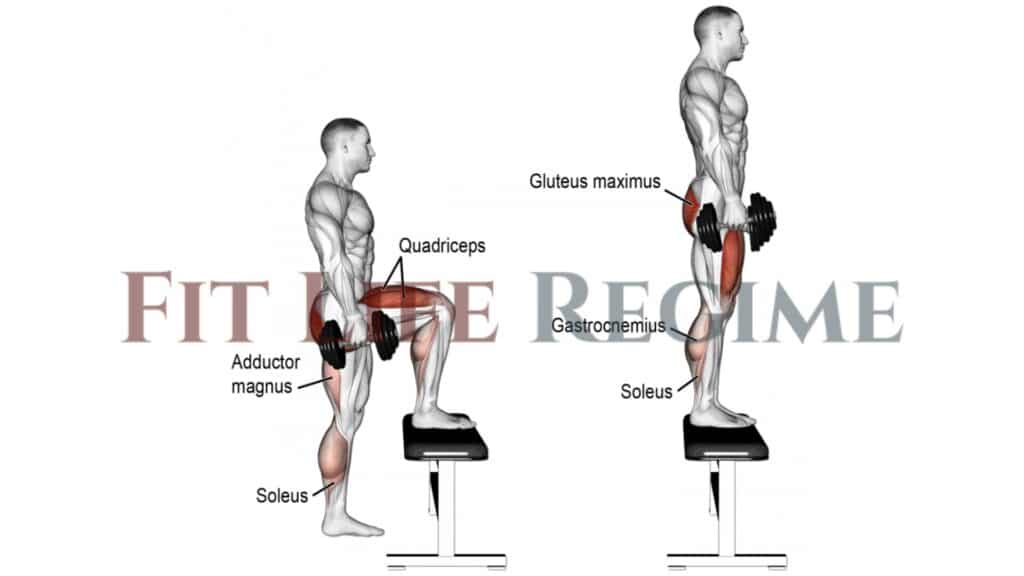
How To Do
- Place a knee-high box or bench in front of you and grasp a dumbbell in each hand, or use your body weight.
- Stand with your feet in a comfortable hip-width stance.
- Step forward with one leg onto the step and drive through that thigh to bring your body upward.
- Bring the trailing leg to the top of the step and stand on the box, then step back with the opposite leg to the floor and lower yourself.
- Alternate legs with each rep.
Tips
- Control the movement, using your muscles to lift and lower yourself slowly.
- Be sure to keep your lower back in its natural arch and your upper body upright throughout the movement.
- Keep your body upright and your feet and knees pointing in the same direction.
10. Dumbbell Goblet Squat
The dumbbell goblet squat is a variation of the squat and an exercise used to build the muscles of the legs. In particular, the dumbbell goblet squat will place a lot of emphasis on the quads.
It is a classic squat variation that utilizes many knee flexions, making it a perfect choice to train the quadriceps.

How To Do
- Select a dumbbell and position it at chest height with one hand under each edge of the dumbbell.
- Take a deep breath and descend by simultaneously pushing the hips back and bending the knees.
- Once your thighs reach parallel with the floor, begin to reverse the movement.
- Keep your abs braced and drive your feet through the floor.
- Drive back to the starting position.
Tips
- Experiment with a “false” (i.e. thumbless) grip, as this helps to eliminate elbow and wrist issues in some folks.
- As you stand, keep your chest high and squeeze your glutes
How To Build Quadriceps Mass (With Workout Plan)
If your quads are lagging, and you really want to build a bigger and stronger one, you can prioritize it, but still, don’t forget about your hamstring, glutes, and Calves.
1. Set And Reps To Mass, Power, And Endurance
Do you care more about speed or endurance? Setting PRs in these particular exercises or building generally useable strength?
Once you’re clear, this table will help you work them into your routine:
| Goal | Recommended Sets/Reps |
|---|---|
| Mass | • 3-5 sets of 6-10 reps • Rest 60 seconds to 2 minutes between sets |
| Pure Strength | • 4-8 sets of 1-5 reps • Rest 2-3 minutes between sets |
| Endurance | • 2-5 sets of 12-25 reps • Rest 60-90 seconds between sets |
| Power and Speed | • 3-5 sets of 3-5 reps (but it will depend on when your explosiveness starts to fail) • Rest at least 2 minutes between sets |
2. Select Weekly Workout Volume
The volume of your workout program refers to the number of sets, reps, and exercises performed in each workout.
A good starting point is to perform 3–4 sets of each exercise for 8–12 reps.
- Beginners (with a year or less of training) should aim for about 12 weekly sets.
- An Intermediate trainee (with two to four years of training) can increase the volume to 16 sets per week.
- An advanced trainee (with four or more years of training) may be able to complete up to 20 weekly sets.
When a certain amount of volume stops working and your progress stalls, you can add sets to increase the volume and use that to make progress again.
3. Quad Workout for Beginners
This is your basic quadriceps workout. It’s ideal for beginners because it activates and wakes up all four heads of the muscle.
Complete all the repetitions for a given exercise before moving to the next one. Take no more than a 90-second break in between sets.
| Exercise | Sets | Reps | Rest (between sets) |
|---|---|---|---|
| Dumbbell Box Squat | 4 | 6-8 | 60–90 seconds |
| DB Lunges | 4 | 8-10 | 60–90 seconds |
| Dumbbell Step Up | 3 | 15-20 | 60–90 seconds |
4. Intermediate Quadriceps Workout Routine
Let’s take your dumbbell quad workouts to the next level using the supersetting method. Use a lighter weight than you normally would for a superset.
| Exercise | Sets | Reps | Rest (between sets) |
|---|---|---|---|
| Dumbbell Squat | 4 | 6-8 | 60–90 seconds |
| DB Reverse Lunges (Superset with step-up) | 3 | 8-10 | 60–90 seconds |
| Dumbbell Step Up | 3 | 8-12 | 60–90 seconds |
5. Advance Workout Routine
For advanced quad workouts, you can add superset along with plyometrics exercises.
| Exercise | Sets | Reps | Rest (between sets) |
|---|---|---|---|
| Dumbbell Front Squat | 4 | 6-8 | 2 minutes |
| Dumbbell Bulgarian Split Squat | 4 | 8-10 | 60–90 seconds |
| DB Goblet Squat | 3 | 10-12 | 60–90 seconds |
| Dumbbell Jump Squat | 3 | 15 | 60–90 seconds |
Benefits of Doing Quad Exercises With Dumbbell
Beyond aesthetics, there are several good reasons to focus on building muscle size and strength in the quadriceps. Here are some of the key benefits you will enjoy if you have strong quad muscles.
There are many advantages of doing dumbbell quad strengthening exercises, such as:
- Dumbbells require more balance than barbells or machines, which can lead to greater muscle fiber recruitment.
- Dumbbell quad-strengthening exercises allow unilateral training, increase core stability, and improve muscular imbalances.
- It affords a greater variety, preventing physical and mental burnout.
- Dumbbells offer adjustable weight increments. This makes it easier to match your fitness level and continue to progress over time.
- Strong quads support speed in running and sports that require sprinting, like soccer. They also power jump in games like basketball, making you a faster cyclist.
- From a purely functional standpoint, you need strong quads to move about your day. They work together to allow you to move the lower leg at the knee and the upper leg at the hip joint.
- Make your quad muscles stronger to prevent injury. You require strong quad muscles to do daily movements. Studies have even shown that having weak quads increases your risk of losing cartilage and developing osteoarthritis in the knees.
- According to a study, compound exercises stimulate the release of growth hormone and increase your metabolic rate.
- Building a powerful quad also helps to: Tone and sculpt legs, Strengthen core muscles, Burn calories and promote weight loss, improve mobility, stability, and range of motion and strengthen bones.
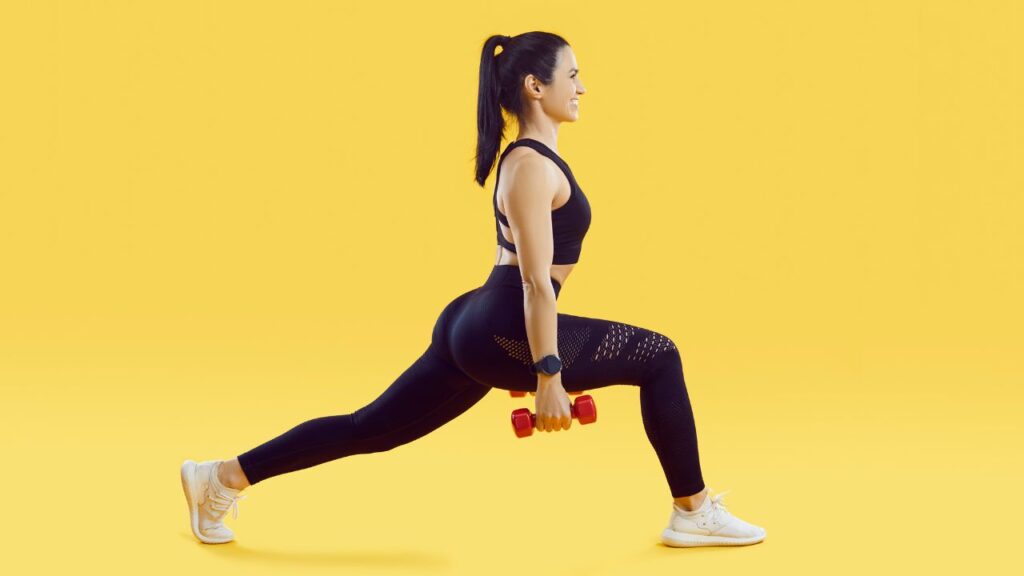
Want to take your gains to the next level? Discover your daily calorie needs with our free TDEE calculator
FAQs
Are dumbbell quad exercises suitable for beginners?
Yes, dumbbell quad exercises are good for beginners. It is also beneficial for beginners to learn more to ensure correct execution.
How many quad exercises per workout
Including 2-4 quad exercises per workout is generally recommended to target and train the quadriceps effectively.
You should do quad exercises 2–3 times a week, with enough rest days in between to help your muscles recover.
Can I do dumbbell quad exercises at home?
Yes, you can do dumbbell quad exercises at home if you have enough space and dumbbells. Dumbbells can be used for various exercises to target your quads, making this a convenient home workout option.
Exercises like hamstring curls, calf raises, and glute bridges can be used to complement your quad workouts and give you a good lower-body workout.
Takeaways
Strong quadriceps can be built with machine and barbell exercises. However, building a tone quad with the dumbbells is possible without the additional equipment.
The dumbbell exercises you’ve seen in this article are different from each other and help you target the quad from every angle, which will help you develop muscular legs.

Manish brings over 10 years of hands-on experience in weight lifting and fat loss to fitness coaching. He specializes in gym-based training and has a lot of knowledge about exercise, lifting technique, biomechanics, and more.
Through “Fit Life Regime,” he generously shares the insights he’s gained over a decade in the field. His goal is to equip others with the knowledge to start their own fitness journey.
